notes : The title has been adapted appropriately , Cancel input step , Adapt to the style of the real problem , A daily topic , continued 30 God
True question link : Programming problem 、txt File operation problem
Because the selected part of the true question uses python2 grammar ,print There's no need for parentheses , So I got used to it print Bracketed can add this sentence at the beginning of the code :
#!/usr/bin/python3
Explain to the correction teacher that python3, That should not be a big problem
Write a function , Given a positive integer m(m>11), Calculation 11+12+13+…+m Value .
def a(m):
sum=0
for i in range(11,m+1):
sum=sum+i
return sum
print(a(21))
It is known that a=[3,1,12,5,14,8,7,2,5,3,2,6,7,2,3,8,5], The program output list can be 2 and 3 The number of integers
a=[3,1,12,5,14,8,7,2,5,3,2,6,7,2,3,8,5]
cnt=0
for i in a:
if i%2==0 and i%3==0:
cnt+=1
print(cnt)
Be careful if What is connected in the statement is and, No C Medium &&
Programming calculation can divide at the same time 14 And 18 The smallest positive integer of ?
for i in range(1,14*18+1):
if i%14==0 and i%18==0:
print(i)
break
Be careful not to overlook range Ahead 1, Otherwise, it will start from 0 Start , The output is 0
a=[2,1,5,1,2,3,1,3,5,6,1,8,2,1,7,7], Arrange the elements that appear twice in the list into a new list
a=[2,1,5,1,2,3,1,3,5,6,1,8,2,1,7,7]
b=list(set(a))# Storage a Different elements in , Use it carefully list() Change to list format
cnt=0
c=[]
for i in b:
for j in a:
if i==j:
cnt+=1
if cnt==2:
c.append(i)
cnt=0
print(c)
There is a cage , There are some chickens and rabbits in it , Common head 14 individual , leg 38 strip , How many chickens and rabbits are there
for i in range(1,15):
if i*2+(14-i)*4==38:
print(f' Chicken has :{
i} only , The rabbit has :{
14-i} only ')
It is known that a=[3,1,12,5,14,8,7,2,5,3,2,6,7,2,3,8,5], The smallest in the program output list 2 An odd number ( A space separates )
a=[3,1,12,5,14,8,7,2,5,3,2,6,7,2,3,8,5]
a.sort(reverse=False)#False Expressing ascending order ,True Representation of descending order
flag=2
for i in a:
if i%2==1 and flag!=0:
print(i,end=' ')
flag-=1
if flag==0:
break
Known dictionaries a={1:4,2:3,4:1,0:12,14:8,10:3,9:4,5:2,15:2}, Pick out all even values , Put the corresponding key into a list and output
a={
1:4,2:3,4:1,0:12,14:8,10:3,9:4,5:2,15:2}
keys=[]
for key,value in a.items():
if value%2==0:
keys.append(key)
print(keys)
Write a function to find a+aa+aaa++⋯+aa⋯a(n individual a) The sum of the .
def an(a,n):
sum=0# Must be placed in the function 、for Outside of the loop
c=a# Storage a, Used with sum Add up
for i in range(1,n+1):
sum=sum+c
c+=a*pow(10,i)
return sum
print(an(1,3))
a=[143,174,119,127,117,164,110,128], Output the list subscript corresponding to the number greater than the average in the list ( Whitespace separated )
a=[143,174,119,127,117,164,110,128]
for index,i in enumerate(a):
if i>=sum(a)/len(a):
print(index,end=' ')
Output a=234153 The number of digits and the sum of the digits , Separated by a space .
a=234153
sum=0
cnt=0
while a!=0:
cnt+=1
sum=sum+a%10
a=a//10
print(sum,cnt)
It is known that a=[3,1,12,5,14,8,7,2,5,3,2,6,7,2,3,8,5], Find the primes and sum them
for-else The meaning of : If it can be divided ( Not primes ),break Jump out of the present for loop , Do nothing ; If it's not divisible ( Prime number ),for After iteration, there are no books break Out of the loop , perform else sentence , Add this prime number to the list
a=[3,1,12,5,14,8,7,2,5,3,2,6,7,2,3,8,5]
b=[]
for i in a:
if i>1:
for j in range(2,i//2+1):
if i%j==0:
break
else:
b.append(i)
print(b)
print(sum(b))
Or by defining a function
def iszhi(n):
if n>1:
for i in range(2,n//2+1):
if n%i==0:
return False
else:
return True
a=[3,1,12,5,14,8,7,2,5,3,2,6,7,2,3,8,5]
b=[]
for j in a:
if iszhi(j)==True:
b.append(j)
print(b)
print(sum(b))
The number of Narcissus refers to a N Positive integer (N≥3), Of the numbers in each of its bits N The sum of the powers is equal to itself . for example :153=1×1×1+5×5×5+3×3×3. Programming , Calculate and output all 3 Number of daffodils .
n=3
for i in range(99,1000):
a=i//100
b=i//10-a*10
c=(i-a*100-b*10)
if i==pow(a,n)+pow(b,n)+pow(c,n):
print(i,end=' ')
seek 1!+3!+5!+7!+9! And , Design with loop nesting .
sum=0
a=1
for i in range(1,10,2):
for j in range(1,i+1):
a*=j
sum+=a
a=1
print(sum)
There are four numbers :1、2、3、4, How many different and unrepeated three digit numbers can be formed ? Program to output all qualified numbers
a=[1,2,3,4]
result=[]
for i in a:
for j in a:
for k in a:
if i*100+j*10+k not in result and i!=j and i!=k and j!=k:
result.append(i*100+j*10+k)
print(result)
Fibonacci sequence , from 1,1 Start , Each of the latter is equal to the sum of the first two , Ask before 18 Sum of items
def fib(n):
if n<=2:
return 1
else:
return fib(n-1)+fib(n-2)
sum=0
for i in range(1,19):
sum+=fib(i)
print(sum)
Judge 101-200 How many primes are there between , And output all prime numbers .
def iszhi(n):
if n>1:
for i in range(2,n//2+1):
if n%i==0:
return False
else:
return True
for i in range(101,201):
if iszhi(i)==True:
print(i,end=' ')
Statistics 1 To 100 in 6 The sum of multiples of
sum=0
for i in range(101):
if i%6==0:
sum+=i
print(sum)
a=[143,174,119,127,117,164,110,128], Achieve maximum exchange with the first element , The smallest exchange with the last element , The output array .
a=[143,174,119,127,117,164,110,128]
mina=min(a)
maxa=max(a)
for i in range(len(a)):
if a[i]==maxa:
a[i]=a[0]
a[0]=maxa
if a[i]==mina:
a[i]=a[-1]
a[-1]=mina
print(a)
Existing list a=[2,3,1,3,2,1,3,5,4,2,1,5,2,3,1,4], Take the number in the list as the key , The number of occurrences is a value , Build dictionary and output .
a=[2,3,1,3,2,1,3,5,4,2,1,5,2,3,1,4]
keya=list(set(a))
cnt=0
result={
}
for i in keya:
for j in a:
if i==j:
cnt+=1
result[i]=cnt
cnt=0
print(result)
Known dictionaries a={1:4,2:3,4:1,0:12,14:8,10:3,9:4,5:2,15:2}, Pick out all key value pairs with even keys and values , Form a new dictionary .
a={
1:4,2:3,4:1,0:12,14:8,10:3,9:4,5:2,15:2}
result={
}
for key,value in a.items():
if key%2==0 and value%2==0:
result[key]=value
print(result)
Write a function , Given any two positive integers m>1、n>1,m≠n, The greatest common factor of both ( The largest number that can be divided by both numbers ).
def a(m,n):
result=0
maxmn=0
if m>n:
maxmn=m
else:
maxmn=n
for i in range(2,maxmn//2+1):
if m%i==0 and n%i==0:
result=i
return result
print(a(140,200))
Yes 100 Bowl rice and 100 personal ,1 A man eats 2 bowl ,2 A woman eats 3 bowl ,3 A child eats 2 bowl , Ask how many men, women and children each ? Give the possibility
nan=2
nv=1.5
hai=2/3
for i in range(51):
for j in range(67):
for k in range(101):
if i+j+k==100 and nan*i+nv*j+hai*k==100:
print(i,j,k)
a=[25,30,36,42,46,49,48,38,24,13,8,6],b=[10,12,14,16,18,20,22,24,26,28,30,32], among a For days ,b Is the demand number , With b As the key a Value , Create a dictionary and output the number of requirements for the maximum number of days
a=[25,30,36,42,46,49,48,38,24,13,8,6]
b=[10,12,14,16,18,20,22,24,26,28,30,32]
result={
}
for i in range(len(a)):
result[b[i]]=a[i]
print(result)
maxdaynum=max(list(result.values()))
for key,value in result.items():
if value==maxdaynum:
print(key)
Find the list [-3,5,7,9,11,7,-1,-12,14,18] Greater than 0 Array into a new list , And output the new list in descending order
a=[-3,5,7,9,11,7,-1,-12,14,18]
b=[]
for i in a:
if i>0:
b.append(i)
b.sort(reverse=True)
print(b)
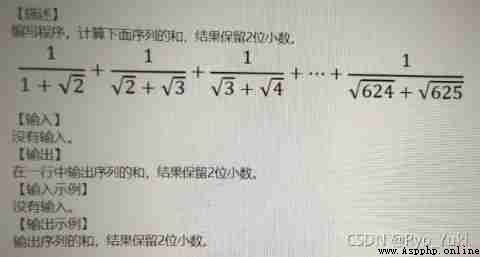
import math
sum=0
for n in range(1,624):
b=math.sqrt(n)+math.sqrt(n+1)
c=1/b
sum=sum+c
print(sum)
print(f' The result is {
sum:.2f}')
In the picture txt The file has been packaged and uploaded , If necessary, you can comment on an email , The code file is placed in the and file Folder under the same level directory
The figure below shows the sales of some goods in a shopping mall in the last four quarters , Stored in a file ( File directory :file/demo1.txt), The separator is ‘\t’, Notice that there is a line break at the end "\n”, The first act is to list , Programming to solve :
(1) Count the total sales of each commodity last year , Take the product name as the key , Sales volume is value output (9 branch )
(2) The average quarterly sales are greater than 1000 The goods , List output product name (6 branch )
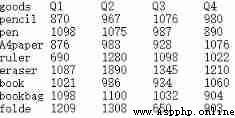
totalSellDict={
}
aveSellOver1000=[]
with open('file/demo1.txt') as f:
f.readline()# Remove the first row that is not related to the data
lines=f.readlines()# Read the remaining rows with data
print('------- Answer the first question -------')
for i in range(len(lines)):
if lines[i].endswith('\n'):
lines[i]=lines[i][:-1] # Put the at the end of the string \n Get rid of , It also prevents the last line from missing \n The situation of
lines[i]=lines[i].split('\t') # With \t Division
totalSellDict[lines[i][0]]=int(lines[i][1])+int(lines[i][2])+int(lines[i][3])+int(lines[i][4])# If you can't write that long on the test paper , You can add '\' Line wrap writing
print(totalSellDict)
print('------- Answer the second question -------')
for key,value in totalSellDict.items():
if value/4>1000:
aveSellOver1000.append(key)
print(aveSellOver1000)
The following figure shows a consumer's background record of various types of goods of a certain brand in a store one day , Stored in a file ( File directory :file/demo2.txt), The first act is to list , among type The column represents the model ,atcion The list shows the behavior (0 Indicates browsing ,1 Represents a collection ,2 Indicates additional purchase ,3 Means purchase ),time The column represents the time ( After decimation , Such as 15.25 Express 15:15 branch ), The separator is ‘\t’, Notice that there is a line break at the end "\n”, Programming to solve :
(1) Output the views of each product in the form of a dictionary (4 branch )
(2) Output the final result of each product in the form of a dictionary ( The behavior of the largest number )(5 branch )
(3) Ask for the model that takes the longest time to purchase after additional purchase (6 branch )
I feel like I have dug a big hole for myself … It was very difficult 、 What a mess , The first question has some value , The last two questions can be skipped 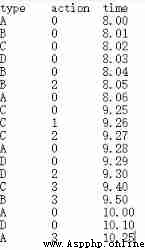
liuLanSum={
'A':0,'B':0,'C':0,'D':0}
state={
'A':0,'B':0,'C':0,'D':0}
startTime={
'A':0,'B':0,'C':0,'D':0}
endTime={
'A':0,'B':0,'C':0,'D':0}
costTime={
'A':0,'B':0,'C':0,'D':0}
with open('file/demo2.txt') as f:
f.readline()
lines=f.readlines()
print('------- Answer the first question -------')
for i in range(len(lines)):
if lines[i].endswith('\n'):
lines[i]=lines[i][:-1]
lines[i]=lines[i].split('\t')
if int(lines[i][1])==0:
liuLanSum[lines[i][0]]+=1
print(liuLanSum)
print('------- Answer the second question -------')
for j in range(len(lines)):
if int(lines[j][1]) > state[lines[j][0]]:
state[lines[j][0]]=int(lines[j][1])
print(state)
print('------- Answer the third question -------')
for k in range(len(lines)):
if int(lines[k][1])==2:
startTime[lines[k][0]]=float(lines[k][2])
if int(lines[k][1])==3:
endTime[lines[k][0]]=float(lines[k][2])
for key,value in startTime.items():
if value==0:
endTime[key]=0
for key,value in endTime.items():
if value==0:
startTime[key]=0
for key,value in costTime.items():
costTime[key]=endTime[key]-startTime[key]
for key,value in costTime.items():
if value==max(list(costTime.values())):
print(key)
break
The following figure shows four employees last year ABC Sales of three categories of goods , Stored in a file ( File directory :file/demo3.txt), The separator is ‘\t’, Notice that there is a line break at the end "\n”, The first act is to list , Programming to solve :
(1) Output for each employee ABC The total sales of the three categories of goods (8 branch )
(2) Output the average sales per employee for each product (7 branch )
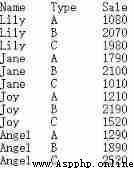
staffSell={
'Lily':0,'Jane':0,'Joy':0,'Angel':0}
aveSell={
'A':0,'B':0,'C':0}
with open('file/demo3.txt') as f:
f.readline()
lines=f.readlines()
for i in range(len(lines)):
if lines[i].endswith('\n'):
lines[i]=lines[i][:-1]
lines[i]=lines[i].split('\t')
print('------- Answer the first question -------')
for j in range(len(lines)):
staffSell[lines[j][0]]+=int(lines[j][2])
print(staffSell)
print('------- Answer the second question -------')
for k in range(len(lines)):
aveSell[lines[k][1]]+=int(lines[k][2])
for key,value in aveSell.items():
aveSell[key]=value/4
print(aveSell)
The following figure shows the comprehensive evaluation scores of several students in a class ( It is divided into moral education 、 Intellectual education points 、 Physical education scores , Full marks 100 branch ), among , According to moral education 20%、 Intellectual education points 70%、 Physical education scores 10% To calculate the total score of comprehensive evaluation . Files are stored in a file ( File directory :file/demo4.txt), The separator is ‘\t’, Notice that there is a line break at the end "\n”, The first act is to list , Programming to solve :
(1) Calculate the total score of each student in the comprehensive test ( Keep two decimal places )(4 branch )
(2) And calculate the excellence rate (85 The above points are excellent , Keep three decimal places )(5 branch )
(3) Output rank in descending order of scores 、 Name and score (6 branch )
The third question is a little difficult , Back up 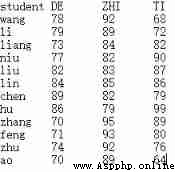
excellent=0
scores={
}
names=[]
flag=0
sortedNames=[]
with open('file/demo4.txt') as f:
f.readline()
lines=f.readlines()
for i in range(len(lines)):
if lines[i].endswith('\n'):
lines[i]=lines[i][:-1]
lines[i]=lines[i].split('\t')
print('------- Answer the first question -------')
for j in range(len(lines)):
Score=0.2*int(lines[j][1])+0.7*int(lines[j][2])+0.1*int(lines[j][3])
scores[lines[j][0]]=Score
print(f'{
lines[j][0]} My total score is :{
Score:.2f}')
if Score>85:
excellent+=1
print('------- Answer the second question -------')
print(f' The excellence rate is :{
excellent/len(lines):.3f}')
print('------- Answer the third question -------')
sortedScores=list(scores.values())
sortedScores.sort(reverse=True)
for k in sortedScores:
for key,value in scores.items():
if k==value:
sortedNames.append(key)
for mingci,name,score in zip(range(1,len(lines)+1),sortedNames,sortedScores):# If you can't write that long on the test paper , You can add '\' Line wrap writing
print(f' The first {
mingci} The name is {
name}, The score is {
score}')
The following picture shows a school during school 18 The number of projects approved at all levels participating in the innovation and entrepreneurship training program at level ,G It means national level ,S Means provincial ,X It means school level , Stored in a file ( File directory :file/demo5.txt), The separator is ‘\t’, Notice that there is a line break at the end "\n”, The first act is to list , Programming to solve :
(1) Seeking the whole 18 The total number of projects approved at all levels of level and output (6 branch )
(2) National level product 5 branch , Provincial plot 3 branch , School grade product 1 branch , Take the class as the key and the integral as the value to build a dictionary and output the scores of each class , And output the class with the highest score (9 branch )
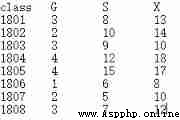
total={
'G':0,'S':0,'X':0}
classPoint={
}
with open('file/demo5.txt') as f:
f.readline()
lines=f.readlines()
for i in range(len(lines)):
if lines[i].endswith('\n'):
lines[i]=lines[i][:-1]
lines[i]=lines[i].split('\t')
print('------- Answer the first question -------')
for j in range(len(lines)):
total['G']+=int(lines[i][1])
total['S']+=int(lines[i][2])
total['X']+=int(lines[i][3])
print(total)
print('------- Answer the second question -------')
for k in range(len(lines)):
classPoint[lines[k][0]]=5*int(lines[k][1])+3*int(lines[k][2])+int(lines[k][3])
print(classPoint)
maxPoint=max(list(classPoint.values()))
for key,value in classPoint.items():
if value==maxPoint:
print(key)